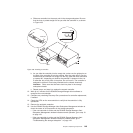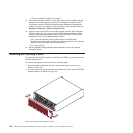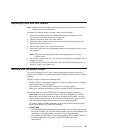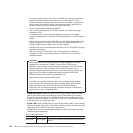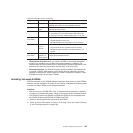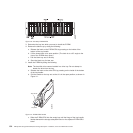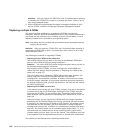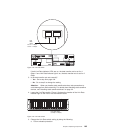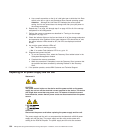v Which method most closely matches the recommended drive upgrade procedure
that is provided in the operating system or the storage-management software
documentation.
v Which RAID level is used on the affected drives. (RAID 0 requires you to replace
all the E-DDMs at the same time.)
v How much downtime is acceptable as you swap the E-DDMs.
v The number of E-DDMs in an array. Replacing E-DDMs one at a time is better
suited for arrays consisting of 3 to 5 E-DDMs. If you have more than 10 E-DDMs
or arrays that are comprised of high capacity SATA E-DDMs, consider replacing
all E-DDMs at the same time.
v How much risk of losing data is acceptable. Because the array will be in a
degraded state during the RAID array reconstruction and copyback process as
result of replacing a drive in the array, any new E-DDM failure will cause the
array to fail (causing a loss of data availability and even a loss of data). The
duration of the reconstruction and copyback process can be quite long,
depending on the size of the RAID array.
v How extensive will the data be changed while the array is in a degraded state
during the RAID array reconstruction and copyback process as result of replacing
an E-DDM in the array. The more extensive the data changes, the more work
that will need to be performed to restore the data in the event that the array
failed because of an addition E-DDM failed while the array is in degraded state.
Replacing all E-DDMs at the same time
Use this procedure to replace all E-DDMs at the same time. You must use this
method if you are upgrading E-DDMs containing RAID 0 logical drives. All the data
currently on the E-DDMs is lost when you replace the E-DDMs; therefore, you must
back up all data that is currently on the E-DDMs. This procedure also requires you
to turn off the storage expansion enclosures and the DS4700 Express, which
makes the storage subsystem (and any attached storage expansion enclosures)
inaccessible to other users.
Attention: After you remove a E-DDM CRU, wait 70 seconds before replacing or
reseating the E-DDM CRU to allow it to properly spin down. Failure to do so may
cause undesired events.
To replace all the E-DDMs at the same time, perform the following steps:
1. Read the following information:
v The information in “Replacing multiple E-DDMs” on page 156, particularly
the paragraphs that discuss the differences between the two possible
upgrade procedures
v The information in your software documentation regarding E-DDM upgrades
and installation
v The documentation that comes with the new E-DDMs
Read all precautionary notes, kit instructions, and other information. Kit
instructions often contain the most current information regarding the
E-DDMs and their installation, plus upgrade or servicing procedures.
Compare the kit instructions with this procedure to determine if you need to
modify this procedure.
2. Use the DS4000 Storage Manager software to check the status of the DS4700
Express. Correct any problems that are reported.
3. Perform a complete backup of the E-DDMs that you are replacing.
You need the backup to restore data on the E-DDMs later in this procedure.
Chapter 5. Replacing components 157



